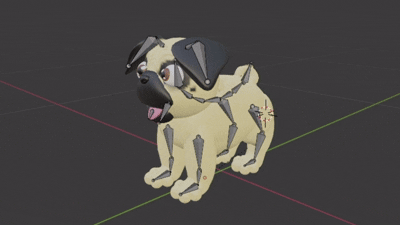Joseph Gorak
Pug Walking Simulator
I had always wanted to work on more personal projects to further develop my skills and learn new concepts. I
brainstormed ideas for game development and thought
of a simulator game as at that time there were many coming out. The concept was simple: The user would play as
an unruly pug who wants to escape their owner and cause
havoc in the town. The two segments would include: leashed segment and free roam segment. The user would be in
a fixed camera setting on a walk around town, and they
must accomplish specific tasks to break free from their owner. Once free, the goal was to explore the town and
cause damage while avoiding being captured by their owner
or other civilians.
Once I drew up the concept, planned out various steps for development. As the creative elements were all
mine and developed from scratch, I began to learn how to
3D model and animate. While undergoing this process, I was looking into the Unity game engine and C#
development. This would be the main development platform
for the game.
Through Unity, I had created the town based on in-game shapes and various models I had created in
blender. These models included fences, various housing and tree types, stop signs, fire
hydrants, and cars. I created user collision boundaries, as well as the ability to walk, run, and jump. I
created both the player character, a pug, and their owner, a boy.
I added a set path movement to the boy to walk around the town. He had a circular boundary around him which
was the player's running radius as they were
tied to them through a leash with the proper movement physics. This was the furthest I reached in development
before more pressing school work, studying, part time work, and projects took over.

Modeling and Animating
The most time consuming part of the process was the model creating and animation. I had begun developing my
skills by watching tutorials and creating various objects and characters
for references. Once I began used to developing models, I began the development of my pug character. There
were a few initial concepts and failures made throughout this process,
as creating the model and having it be properly animated are two very different processes. My initial attempt
was rather poor, and I had learned from this and redeveloped the model.
Once I was satisfied with the design of the pug, keeping the vertices on the model relatively low to not
take away from game processing time, I began animating. I created a simple
skeleton throughout the model and linked the various parts to their respective bones. Once I began testing
movement and everything appeared to run well, I developed various
poses. There was default standing, walking, running, jumping, sitting, and typical dog poses. I also created
various different colored pug models and a few cosmetics with the intention to allow
for user customization. From here, these animations were linked to the various actions performed in game with
a a little bit of tweaking from the animation loops to improve the look. I had also gone through a
similar process with the boy character so I could have an animation for him walking. The main aesthetic goal
for the game was simple yet cartoonish.

Lessons Learned
The game development process was mainly done through trial and error as I have had no previous experience
before. This had allowed me to grow my skills extremely quickly as
I experimented with various styles of model creation and animation. By going through different stages in
creation, I was able to bring my ideas to life. This was also my first time
working on a game environment so I was able to create various collision and motion controls and watched how
they acted in the game environment. This was also
seen as each control could change the animation of the user character.
By working with different models, I learned about the importance of keeping vertices low enough with
models to keep aesthetics yet increase performance.
As I developed the whole town, I learned various strategies to creating proper boundaries while also
increasing the visuals of the surroundings.
Skills Learned:
- Unity game development
- Dynamic collisions and character animations
- 3D modeling and animation through blender